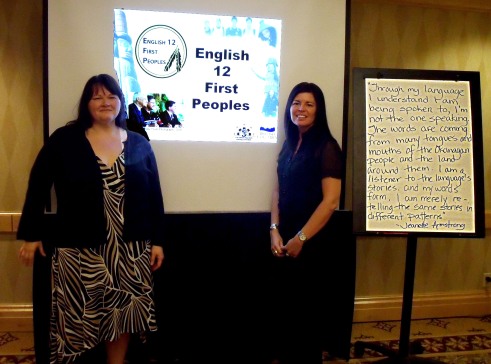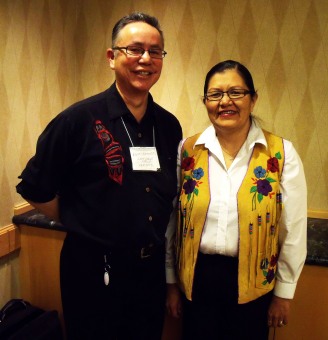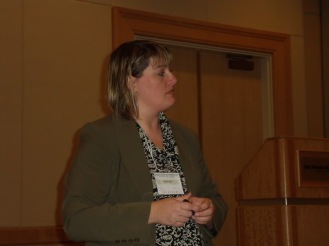Strengthening Connections
Strengthening connections was the theme of the 14th Annual FNESC Provincial Conference. So, what does strengthening connections mean? Does it mean upgrading your wireless router for a better connection? Adding some extra duct tape to your shoe so the sole will stay on? Or does strengthening connections mean engaging students more in their learning by including more cultural content and by doing so strengthening their connection to their education? Or does it mean strengthening the connection teachers have with their student by improving the structure of their classroom and their teaching style? I think the last two make much more sense and that is what I got out of two of the workshops I attended.
The Engaging Aboriginal Students Through Imagination workshop discussed many of the ways teachers can better engage aboriginal students, though their imaginations and emotions. Dr. Lee Brown said earlier in the day that “You can feel without thinking, but you can not think with out feeling.” He also shared with us that how well a student does in school is directly related to how well he or she is developing emotionally. Speaking specifically of aboriginal students, Dr. Brown said that if teachers bring in more aboriginal content and aboriginal values into the classroom, these students will be engaged emotionally and therefore become more likely to succeed. The presenters at the workshop expanded on this subject by giving suggestions for lesson plans, sharing personal experiences and by explaining how including more cultural content in the classroom can give aboriginal students a better sense of identity, and a better sense of belonging. This was also one of Dr. Brown’s beliefs as he said “Emotions become values, and values become identity.” Students and teachers both have to work on being emotionally connected to learning to be successful.
In the Putting the Pieces Together work shop, presenter Stacy Bernard spoke on building a curriculum of caring. Her emphasis was that teachers need to love their students, and build a relationship with them so that the teacher can become an attachment figure for the child. She added that it does not mean a teacher has to love the student in an adoring way but to care about their feelings and their education. Stacy stated that teachers need to build a “climate of support” in their classrooms, and create structure so that everyone knows what is expected, or in her words, “You know that I know that you know that I know.” She said that teachers need to learn their responsibilities as educators, so that students can feel safe at school and be guided through the most important years of their life. She closed by saying that we need to have emotional and morale educators in order to create a safe atmosphere to express emotion for students. Stacy told teachers to “give the students their hearts, because they are giving you theirs.”
This conference has truly shown that it takes a community to raise a child. It is not in the hands of one single person. It’s through the efforts of students, teachers and cultural leaders that success rates of aboriginal students can continue to rise so that we may look forward to a brighter tomorrow.
ENPAAUK
Originally uploaded by carmelita.abraham
ENPAAUK
Andrew Mark Dexel
Artist
Http:/www.flickr.com/photos/entaauk/
Email:
fusionary@msn.com
604.562.6053
This artist is one to be remembered! I felt so happy to see such a young artist. I am pulled in by the colors and strong feeling of First Nations history. It’s so good to see youth working in a cultural medium as a career choice.
I have a business too and I know that any sale is a good one! I am proud of my business and I’m thrilled to see other young, First Nations entrepenuers getting their stuff out there! Good work!
Yours truly,
Carmelita Abraham
Miss Takla (Blogger of the North.)
Spirit Dancer
Spirit Dancer
What a great name! I like the whole vibe in this picture and I have a soft spot for the child who is so smart. The children who attended the 14th Annual FNESC Provincial Conference made the whole event worth attending. It’s beautiful to see the future in the eyes of the children we are working to better education for. The children are important and should be recognized for working and attending at an event such as this one.
So I am happy to present to you:
Spirit Dancer
• Hand Engraved
• Silver plated & diamond cut on copper
• * No Polishing
• Surgical steel
Calvin Harry
(604) 598-3032
(778) 386-6071
Chspiritdancer@yahoo.ca
Wade Webster fom Lytton BC
Wade Webster is from Lytton BC. He is 9 years old and stood out from the rest at the 14th Annual FNESC Provincial Conference in Vancouver, November 27th to the 29th of 2008.
It’s wonderful to see the very young youth of today getting involved in such complex kinds of conferences! Far beyond there years in wisdom with no problem fitting in. The spirit of this picture captures the adorable nature of young Wade. Our youth are interested in the process of learning at conferences provided by organizations like FNESC and it’s great to see it in action.
I feel happy when I see this picture. I love to see kids attend conferences with the drive to learn about what’s going on. I believe this is what our future needs, people to recognize this type of thing and be driven to go out and make a difference some how.
Yours truly,
Miss Takla (Blogger of the North)
English First Peoples Course Now Implemented

- Joanne and Karmen, creators of EFP 12 at end of presentation.
Karmen Brillon – FNESC Curriculum and Exams Coordinator, and Jo-Anne Chrona – Teacher at Prince Rupert Secondary School introduced the English First Peoples 12 Course in 2007 and released it to schools as a Pilot Program in the Fall of 2007.
The EFP12 course is hoped to be accepted at a provincial, national and international level, although it has not yet reached the international level yet, it has reached some parts of Canada including the North West Territories. EFP12 was originally planned to be piloted to 10 schools, but changes were made immediately to accommodate 14 lucky schools. My former high school, Stein Valley Nlakapamux School, was the only First Nations Independent School to grasp the opportunity as one of the 14.
During the Pilot term, EFP12 had proven itself to be successful, although children and parents found it to be challenging, they enjoyed it so much, it showed in the course examination. There was a success story mentioned during the time spent with Karmen and Anne, it brought us to knowing that course references really aren’t as “lame” as they seem, they’re “terrific” when planned out the right way. EFP12 is now a credited course and is currently being accepted by many recognized institutions, and Universities, it can also be used in obtaining Scholarships. For more visit www.fnesc.ca/efp12
After being piloted, the course has been implemented in 40+ First Nations and Non First Nations Schools across Canada. The demand for this course is in higher demand and is being met with high hopes. There are plans in the making for new EFP courses to be taught in the Grades 10 and 11 curriculums, these plans are projected to enter schools in the fall of 2008.
This course would not have been a success if it weren’t for the hard working advisory team that helped put it together, the students and parents played a large role in keeping this course alive for more to enjoy.
Poetry in Motion
When I first looked at the workshop title all I saw was poetry and it sparked my interest, but when they started to explain what it was about, a whole new side of things came out. Being a child who grew up with both my parents in a safe and nurturing environment, thoughts of pain and suffering from being without them never crossed my mind. I listened to Shelly Johnson, the former CEO of Surrounded by Cedar, talk of a girl who had been in foster care since she was a baby and how she went thru 64 foster homes in 16 years, she is currently incarcerated. It is said that for every foster move there is 6 months of suffering for a child. 
Jessica Stephens, of Surrounded by Cedars CFS, and her mom Kathy Robinson, also presented. Jessica talked about the spiritual side of the program, the kids finding themselves thru smudging, prayers, and dancing, with masks and skins, all of which give strength and emotional healing. She teaches the children about balance, balance with mother earth, and how she has 4 directions, seasons, nations, moon cycles, life cycles, elements and the power that the 4 has in balancing us. The program inspires courage and strength within the children because it engages them fully in the learning process, participation and inclusion of the children is a key element to success, making them feel safe and comfortable in their environment.
The Child, Family, and Community Services Act stresses the importance of preserving the child’s cultural identity, as well talks about their best interest being priority meaning their safety, development, quality and maintenance of relationships, views, and cultural heritage, no where does it talk about making their education a priority. The outcome is horrific, 80% of child-in-care do not graduate, 13% graduate with a certificate and only 7% are post secondary ready, of the 9400 BC children in care only 1.4% are prepared when they leave high school. Not only does it show educational precedence but it also reflects the parenting skills. 
The Life Books provide an opportunity to offer children and family a visual history of their lives, there are two different books, Creating a Path for aboriginal children and My Journey for non-aboriginal children. Encouraging people to use the books, Surrounded by Cedar hopes that they will help build a strong sense of personal history and identity for the children. Their intention is to create different educational experiences, increased sense of positive identity and belonging, and restored self-esteem and hope, while attempting to change the emotional response towards school and education within communities that will have a positive future impact leading the way to educational success for children-in-care.
- Was made by one of the students in Jessica’s program.
For more information visit: http://surroundedbycedar.com/life.php
Sekwaw Matthew – Inspiring Youth

“Education is the future.” Says Sekwaw Matthew, she is four-teen years old, from Adams Lake, and is a member of the Simpc First Nation. She gave a very powerful address which was inspiring to both youth, and those who work with youth. She emphasized the importance of having goals as a youth, and asked youth workers to “Remember what you do, you can support youth and help them to achieve their goals.”
Sekwaw gave a large part of her address in Secwepemctsin, her native language, which she is learning at Chief Atahm School in her community. This was outstanding considering that this language is in danger of being extinct. Less then four percent of the Secwepemc are fluent speakers of the language.
The possibility of losing a language is not specific to this community though, many aboriginal languages are on the verge of disappearing. For example in my own community, Hupacasath, we only have 3 fluent speakers of the Nuuchaanulth language. With the passing of two fluent speakers in the last year, it makes it extremely important that we try to preserve our language through the elders that are still alive, and we need to do it quickly.
Preserving the language is not easy though, and often comes with a little controversy, with such questions as how do we document it? Who should be involved? Will it still be sacred? There is no one answer to any of these questions, but in my personal opinion I believe the way to go is through youth and new media. The youth are the future of any culture, and as such we need to document the culture in a way that they can relate to, and with new media the possibilities are endless. Whether its photos, videos, or audio recordings, they can all be digitalized and preserved forever. But then comes the question of how sacred will our language remain? My belief is a matter of how learners use it; I believe sacredness comes from the heart and that if you treat it in such a way then that’s what it is. But regardless of how it is done it needs to happen, we can not afford to lose our culture, we can keep it alive, and we must keep it alive.
Jump Math
Originally uploaded by carmelita.abraham
JUMP MATH
What are your biggest challenges in teaching math?
During the time I spent in the Jump Math workshop there were some issues that caught my attention. I found that learning math has a lot of surrounding issues that affect the rate of success for a student. If a child isn’t eating properly they will have difficulty concentrating so it’s important for students to have a diet high in nutrients. Bananas and apples are nutritional foods that improve a child’s ability to concentrate. Parents should always make sure their child/ren are eating healthy every morning and not eating junk. Another interesting fact I learned was that if a child has difficultly with writing skills it can affect their anxiety levels in other areas such as math, if a child has trouble reading an equation they will have trouble understanding the math concepts.
I listened to Liz Barrett speak about the way some kids write their numbers backwards and how it is a contributing factor to the reason why a student has challenges learning basic skills. Teachers have to lend extra support to students with dyslexia to help them achieve basic skills.
I felt a sense of happiness knowing that there are ways to help children with difficulties in math. It was great to know that there are ways to identify learning disabilities though very specific testing. For example, we learned in the workshop that if a child is placed on their stomach and asked to simulate a breast stroke in a pool and they cannot coordinate their arms, they may have a learning disability and need further testing.
Thank you for your time. I hope this helps you in your journey with teaching math to your students.
Yours respectfully
Carmelita Abraham
Sense of Belonging
Jennifer Auld from SD70, Ucluelet Elementary, was able to capture her audience with her views and work in making a sense of belonging for First Nations students in there educational environment. She explained how students that feel they do not belong in a class room would not do as well academically. Through her work she has been able to provide proof for all to see. In amazement she asked a question that I never thought of; when you look in your schools, do you see anything that you can see that represents you and your culture? I can’t really think of any schools that I went to during my years that contained any thing to do with my culture. This question really made me think. My first thought was how are we going to be proud of our culture and ourselves if we aren’t being notice as s part of the rest of the world. Followed by how can we show the world how exciting and interesting we are as a people through our culture. Also, how do we involve other people and cultures to share in our traditions and beliefs? I think that all we have to do is take the first step and be proud for all to see.
Lake Babine Nation Promotes Language Program
Chief Betty Patrick of Lake Babine Nation and Monty Palmant ier the Education Director of LBN & UNBC School of Education, introduce an innovative Language Teacher Education Program.
ier the Education Director of LBN & UNBC School of Education, introduce an innovative Language Teacher Education Program.
Teaching a traditional language can be one of the most difficult subjects any teacher can learn to teach, especially since it is one of our ancestral values. With the newly developed education program for teachers who wish to teach it in the classroom. Teaching traditional language can be very difficult for those who have not had proper training to do so, the program ad been implemented throughout the LB Nation’s schools to improve the teaching quality of the teachers.
Although the population of LB Nation is only 2,400; the youngest fluent speakers of the Tsay Kay Dene Language went from the elders to the mid 30s range. “Behaviours reflecting Values reflecting Philosophy” says Monty as he shares his enthusiasm in the programs success.
The significant improvement struck ideas that the new language program should be implemented in other First Nations Schools as well as Universities, Colleges and Institutions that have traditional language courses.

















